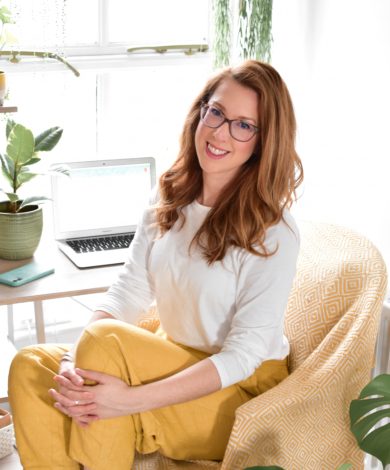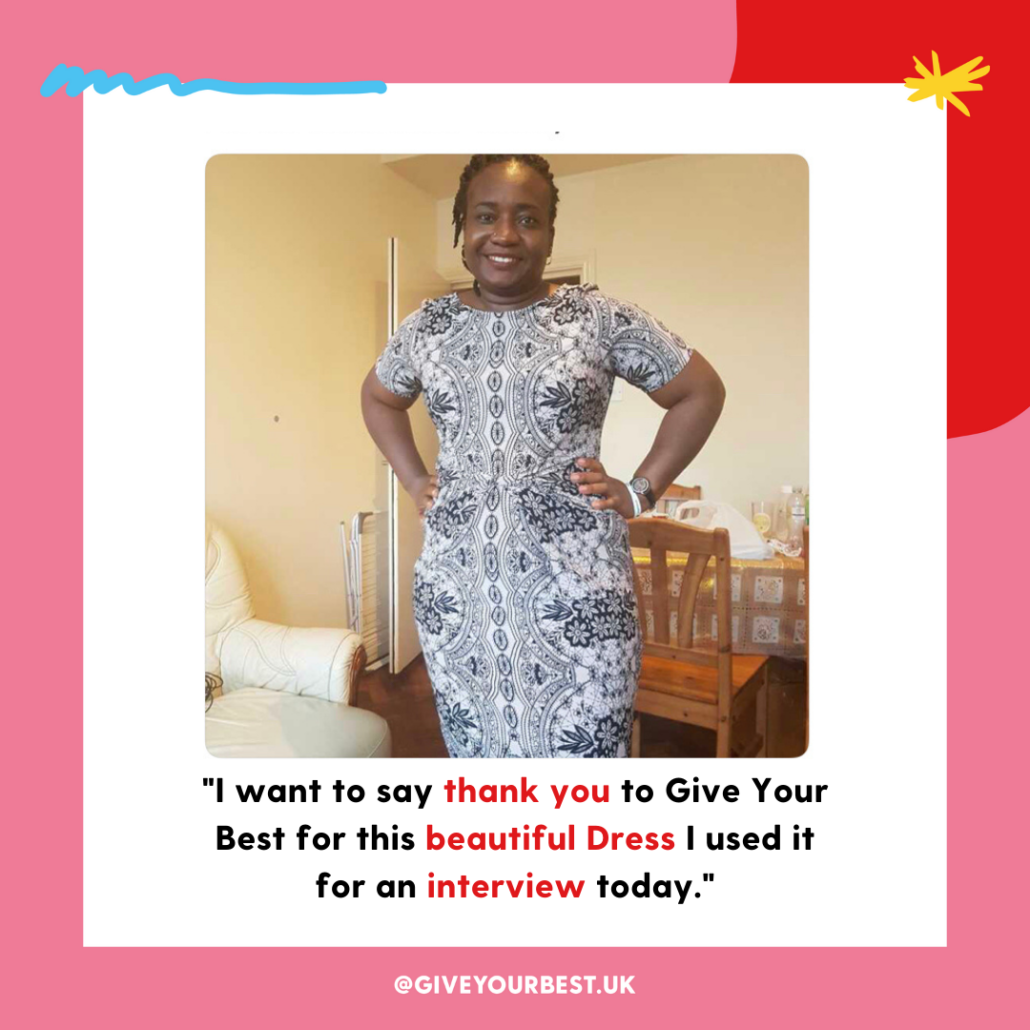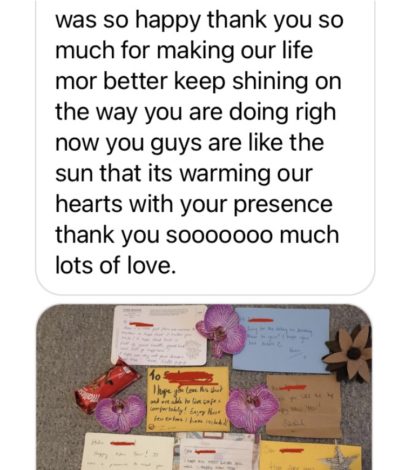 681
681  10 mins
10 mins Give Your Best founder Sol Escobar believes that people should be able to choose clothes they want to wear.
Obvious, isn’t it? Not if you’re one of the 225.000 refugees or asylum seekers living in the UK. Many people from this community live in clothing poverty, without proper access to clothing. Forced to rely on the charity of others, they have few options when it comes to choosing their clothing.
Sol wants to change that. She understands that our clothes tell stories about who we are and how we want to present ourselves to the world. Because she believes that choosing the clothes we wear is a fundamental human right, this courageous, caring and generous woman decided to launch Give Your Best. It’s an Instagram-based clothing shop where refugee and asylum-seeking women can choose what they want to wear from a catalog of donated clothing.
She has created an online shopping experience that lets shoppers browse a catalog to find the clothes that suit them best. But there’s a twist – all the clothes and shipping are free.
Sol is dynamic and engaging. Managing the shop alongside her full-time post as a university education specialist, she connects a community of hundreds of volunteers, givers and shoppers with a catalog of thousands of clothing items. It’s a community that is helping to restore people’s dignity – with the simple, brilliant idea of allowing them to choose their clothes.
It’s a powerful solution, “A new way of doing things”, says Sol.
We needed to know more. We sat down to talk about how her idea is changing lives, and we learned that she also hopes that the success of Give Your Best can be expanded to begin to tackle the subjects of clothing poverty and donation waste on a larger scale.

Portrait of Sol Escobar – courtesy of Give Your Best
What were you trying to do when you started Give Your Best ?
During the lockdown, I was in touch with a household of women seeking asylum in Wales. They were in a shared house that was quite far from the centre of town, and it was quite difficult for them to access anything. They had been placed there by the Home Office.
I decided to do an ad hoc fundraiser for these women on my Instagram and Facebook. I wanted to send them toiletries and menstrual products and I also asked if anyone had any clothes that we could send them. Two things happened – the fundraiser blew up – I raised £1,000 in 24 hours. And secondly, I also had many, many offers for clothing.
On the one hand, I didn’t want to tell people, “Thank you for being so kind and wanting to help, but I can’t handle all these clothing donations.” And on the other hand, I realised that I couldn’t just send all these clothes to these women. I didn’t know if they were going to like all the clothes, if the clothes were going to fit them or if it was even their style.
So I had an idea. I talked to them and asked, “If I take photos of everything that people have to donate, and I open an Instagram account and upload the photos, could you and everyone in your household just have a look through what’s there and choose what you like ?” It created a bit of a shopping experience. I only sent what they actually chose, in their size. And on top of that, there was no waste either.
They loved the idea. So we went ahead with it. But at the same time, I remember one of them saying, “Don’t go through all of that trouble. That takes a long time – just send us what you have. We are in no position to refuse anything.” Hearing that, I thought, “They are dealing with a system that is designed to strip them of their dignity and their agency. They will probably continue to carry this sense of ‘only being worth what they are given’ even after they get their refugee status and start rebuilding their lives.”
Fashion and clothing aren’t the luxury people think it is. It is a basic right to be able to wear what you want. So I thought, “If what we are doing here works for them, it could work for other people in the refugee community!”
So we decided to try it out and that’s how Give Your Best started.
How does it work, can you talk to us about the actual processes ?
Our shop is on Instagram, but we know that IG is not accessible to everyone, so we also have a website. Donors send us a photo of the item which we post with a description, including the size and brand. New items are uploaded onto our shop every Saturday.
Our shoppers can browse through the collection and choose up to 5 items of clothing per person per week. The clothing is free, and shoppers place their orders by messaging us. Then we contact the donors who agree to ship the clothing directly to the shopper’s address.
Incredibly, 85% of all donations we receive are from people who upload and submit their clothing items on our database. They themselves pay for the cost of shipping once somebody has placed an order.
It’s complicated to do everything manually, but this is the only way we have found to have a visual shop that also protects the shoppers from being contacted directly online.
We have created a very strong community that works
in a very meaningful way.
We encourage the women who are donating
to turn their clothing donation into a gift.
Maybe they write a note or add some extra little things.
The donors know that they are sending this package to a woman
who is the same size and has the same fashion sense
but living in a very different situation.
Refugees and asylum seekers are a vulnerable community. We have to make sure that there is no direct communication between them and the people making donations. The process behind the scenes is actually incredibly complex to manage. For months, we tried to find another platform along the lines of Depop or Vinted, but we never found quite what we needed.
As a result, we began applying for grants to develop our own platform.
And last month, we got a Tech For Good grant to develop our own platform! People wanting to donate clothes can upload pictures directly onto our platform. They can have their own profile and see what items have been shopped, what they need to ship, etc.
For the shoppers, it will be like any other e-commerce experience. They will be able to add to their cart and check out – they just don’t have to pay for what they choose.
We are now building this, hoping to launch it in the next couple of months. We are all very excited because the entire team has been dreaming of this moment for the last 6 months. Right now, we are very much at our limit in terms of how many items of clothing we can process and how many shoppers we can support. To give you an idea, we have received nearly 10,000 items of clothing so far. Each item has been manually processed by one of our volunteers. They upload a picture onto our shop, process the orders, contact the donors, and also check that all the items have been received.
The fact that the new platform will automatically manage all this is amazing! There won’t be a limit to how many items of clothing we receive or how many people can shop!

Shopper wearing a dress shopped on Give Your Best – photo courtesy of Give Your Best
This sounds like quite an organisation. Can you tell us some more about who is involved and what do they do?
In total, we have 200 volunteers. They are divided into 2 primary groups and several teams.
The first group of over 60 volunteers is the core team that runs Give Your Best. They run the operations, communications and business development that keeps Give Your Best going and growing.
We also have about 160 people in the second group that we call “Give Our Besties”, which is very cute!
Our besties volunteer and act as clothing collection points across the UK. We had to create this team because we increasingly had people who really wanted to support us, but for different reasons, they didn’t have time to take the photos or handle the shipping. Our besties allow these people to drop off a bag of clothing and will then take the photos, upload the items and ship them. Our besties also allow us to use their houses to store clothing awaiting shipment.
How do you see the impact of what you are doing ?
On a larger scale, we have more than 700 women from asylum seeking and refugee backgrounds who shop with us regularly. We are hoping to be 1,000 at the end of the year. On the donor side, we’ve already had more than 1,300 people who have donated clothes to us, even though our system is not at all user friendly.
This is a huge impact.
Our shoppers are constantly giving us feedback, sending us messages, screenshots and photos of these notes all the time.
It’s the sweetest thing in the world.
Receiving the notes and knowing that people support them
means so much to our shoppers.
One of our shoppers showed us that she had saved every single note
saying, “I read them all the time.”
But on a more personal side, we’ve also just come a bit “full circle” with one of our volunteers.
She was one of our first shoppers, right at the beginning, when we first started. She had just received her refugee status, was looking for working and she began shopping with us for work clothes. We started chatting, and she also decided to volunteer with us. She’s been volunteering with us ever since. She and a couple of other volunteers from the community actually inform a lot of what we do.
Then, last month, we received a small grant to employ someone. She is now going to be the first paid employee in the organisation. She came to us for work clothes, to go to interviews and now we can finally employ her! I would have never imagined that I would be able to give employment to a refugee woman from the community! She will be in charge of our community support and outreach, working with the women in the community to support them further.
She tells us all the time about how empowering it has been for her to access clothing, shop what she likes, and feel confident. Speaking at one of our events, she explained how people no longer judge her by her appearance because she has been able to wear really nice, quality clothing that she really likes. The feeling of being judged was something that she felt during 4 years as she was awaiting approval of her refugee status. 4 years is a very long time to not have access to anything.
It is a very nice story that we can now employ her at Give Your Best.
Another woman told us
“Before shopping with Give Your Best,
I used to think that I was not welcomed in this country,
because all of what I had seen in the news and online
was just hate towards people in my situation.”
What are you hoping to achieve ultimately with Give Your Best ? What are your goals?
That is a good question! When we first started, we didn’t know where this was going. It was all surprising and wonderful – anything that would happen was an achievement.
But since our first anniversary last year, we started thinking, “This is an organization now, we do have a lot of impact and we can turn this into something more.”
So in terms of goals, we want to expand the community that we support. At the moment, we focus on asylum-seeking and refugee women. That’s because this is where I had experience when this first started; those were the people I was supporting at the time.
But we want to expand our services to the whole refugee community, to begin with.
It’s humanising.
Refugees are not just headlines about people experiencing a crisis,
a refugee is a person who is on the other side of this package.
Then, eventually, we’d like to expand to the whole community of all the people who live in clothing poverty. There are 5.5 million people who live in clothing poverty in the UK. And at the same time, millions and millions of clothing items are going to waste.
We want to start a new way of doing things.
The donation waste in clothing in the UK is actually a very big problem. People tend to donate things to charity shops or other organizations, and there is a lot of waste. Some statistics recently came out showing “as little as 10-30% of what is given to UK charities overall actually ends up being sold over the counter.”
Additionally, in the UK, the primary way of recycling or extending the life cycle of clothing is reselling with either apps or charity shops. But because of the prices, reselling clothes doesn’t do anything for people experiencing clothing poverty.
What we want to do is to create a solution that doesn’t exist at the moment. We want to go beyond emergency relief by creating a space where people can have a shopping experience. We want people to feel good about accessing clothing. And we want people to be able to express themselves and wear what they are comfortable with, without having to pay for it.
Nothing like this exists now, and it’s challenging to create that space, but it’s what we want to do. We have been developing partnership programs for clothing brands, resellers and retailers, where we can redistribute their unsold stock via our free shop. In this way, they get to dispose of their unsold stock in a sustainable, socially impactful way.

feedback message from Give Your Best shopper – photo courtesy of Give Your Best
Our tagline is inspiring people, inspiring people – we consider you to be an inspiring person Sol, but who inspires you?
The women we support – these amazing people I’ve met who have been through absolute hell in their lives and yet have the most resilience, the most bravery. They are just amazing. I look at them to keep going. I want to make their lives a tiny bit easier because I know how hard their situation can be. Immigrating to the UK was really difficult for me even though I had all of the privileges in this world, including my passport. People who arrive here and don’t have any of that, yet still keep going and doing what they do. I find them incredibly inspiring. We should be honoured to have them in our country. I feel honored to have friends that are amazing people. And I think we should be embracing that in our culture, even if it doesn’t always happen that way.
Before we go Sol, is there anything else we should know ?
I would like to reiterate – I’m not an expert. My background is in education, I’ve been a university lecturer for 15 years. I’m not trained in business, or in social entrepreneurship. I just had an idea that I thought could help people, so we gave it a go. When I did, so many wonderful people that know much more than me joined the organization and that’s how we are able to do it.
So if someone has an idea of something that they think could help, just give it a go! Who knows? You have no idea what you can achieve!
Everyone wonders “What is the worst thing that can happen?” It would be better to ask yourself “What is the best that could happen?”
Give Your Best goes beyond the best that I could have imagined.
Try! And if it doesn’t work, just stop doing it, and you go back to your life as it was before.
But try.
For more information
Find more information on Give Your Best on their website or visit their Instagram, Facebook, Twitter or LinkedIn.
Until they set up their brand new platform, you can also access their online shop on this Instagram page through their website
Feature image: courtesy of Give Your Best


 James Morano courtesy of FILSAA
James Morano courtesy of FILSAA